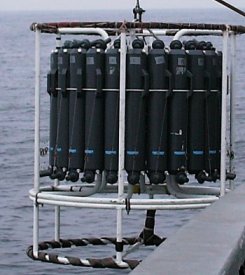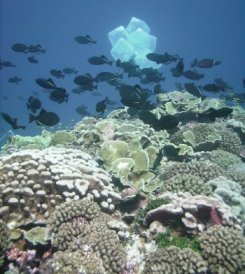Faculty Profile


|
|
Dinsdale Lab Web Page
Research in the Dinsdale lab
Viruses in the marine oxygen minimum zone off Iquique, Chili

Oxygen minimum zones in the ocean are increasing dramatically and affect ocean productivity and fluxes of greenhouse gases. In geological times anoxic oceans correlate with massive extinction events. Given the low levels of oxygen, these zones are microbe dominated and their metabolism contributes to the flux of greenhouse gases. It is hypothesized that viruses play a significant role in controlling microbial growth and activity within these zones. However, our preliminary results suggest that while viruses are abundant they do not conform to the normal microbial/viral relationships. Metagenomic analysis shows the viruses are novel, ~ 2 % sequence similarity to know genomes, and many are similar to Eukaryotic viruses. Given the importance of viruses in controlling microbial (Bacteria and Archaea) populations in most aquatic environments, are anoxic zones within the ocean places where the normal microbial/viral rules vary, and contribute to the establishment and/or maintenance of these near dead zones?
From the bottom up - Role of microbes and viruses in ecosystem health – comparisons of kelp forests and coral reefs

Microbes and viruses are the most numerous entities in the ocean and their activity drives the cycling of organics and nutrients, and affects ecosystem health. We are all aware of specific pathogens and their role in causing disease to larger organisms, but we know less about how environmental microbial communities respond to changes in human activity In the coral reef case study, conducted in the Northern Line Islands, Central Pacific, increases in human activity, in particular fishing, was correlated with an increase in the abundance and pathogenicity of the microbes. The microbial community switched from a balanced autotrophic/heterotrophic community to one which was dominated by heterotrophs. The change in the microbial community was correlated with an increased prevalence of coral disease. For coral reefs we are investigation how microbial growth is induced. For Kelp forests, we are investigation whether a similar change in the microbial community occur as the kelp forest and is involved in the switch to urchin barrens.
Metagenomic functional analysis and statistics
Metagenomes or environmental genomics are a random sample of all the microbial and viral sequences from a sample. These samples are particularly powerful in describing the function and taxonomic distribution of the microbial community. Comparative metagenomics, which compares the function of microbial communities across multiple environments has shown that it is possible to identify what function is important in each environment. Perturbations in the function of the microbial community can be identified and these are being studied in greater detail to identify whether these perturbations occur with changes in human activity. We are currently investigating the functional changes across 380 metagenomes collected from about 10 environments.
Current post doc:
Alejandra Prieto-Davo PhD,
Scripps Institution of Oceanography, 2008 aprietodavo@projects.sdsu.edu
Current Masters Student:
Chris Lewis, Part time
Computational Sciences BS in Molecular Biology
University of Texas at Austin
Selected Publications
- Dinsdale, E.A., R.A. Edwards, D. Hall, F. Angly, M. Breitbart, J.M. Brulc, M. Furlan, C. Desnues, M. Haynes; L. Li, L. McDaniel, M.A. Moran, K.E. Nelson, C. Nilsson, R. Olson, J. Paul, B. Rodriguez Brito, Y. Ruan, B.K. Swan, R. Stevens, D. L. Valentine, R. Vega Thurber, L. Wegley, B.A. White, and F. Rowher 2008 Functional metagenomic profiling of nine biomes. Nature 452:629-632
- Dinsdale, E.A. and F. Rohwer 2008 Dissecting microbial employment. Nature Biotechnology 26:997-998
- Dinsdale, E.A., O. Pantos, S. Smriga, R.A. Edwards, L. Wegley, F. Angly, E. Brown, M. Haynes, L. Krause, E. Sala, S. Sandin, R. Vega Thurber, B.L. Willis, N. Knowlton, F. Azam, and F. Rohwer. 2008. Microbial ecology of four coral atolls in the Northern Line Islands. PloS One 3(2) e1584
- Brulc J M., D.A. Antonopoulos, M.E. Berg, M.K. Wilson, A.C. Yannarell, E.A. Dinsdale, R.A. Edwards, E.D. Frank, J.B. Emerson, P. Wacklin, P.M. Coutinho, B. Henrissat, K.E. Nelson, and B.A. White 2009 Comparative metagenomics of the rumen microbiome by random sampling pyrosequencing. PNAS 106:1948-1953
- Breitbart, M, A. Hoare, A. Nitti, J. Siefert, M. Haynes, E.A. Dinsdale, R.A. Edwards, V. Souza, F. Rohwer, D. Hollander 2009 Metagenomic and stable isotopic analyses of modern freshwater microbialites in Cuatro Ciénegas, Mexico. Environmental Microbiology 11:16-34
- Sandin, S., J.E. Smith, E. DeMartini, E.A. Dinsdale, A. Friedlander, J.B.C. Jackson, N. Knowlton, M. Malay, J. Maragos, D. Obura, G. Paulay, M. Richie, S. Walsh, E. Sala. 2008 Degradation and recovery of coral reefs across a gradient of human disturbance. PloS One 3(2) e1548
- Qu, A, J.M Brulc, M.K. Wilson, B.F. Law, J.R. Theoret, L.A. Joens, M.E. Konkel, F. Angly, E.A. Dinsdale, R.A. Edwards, K.E. Nelson, and B.A. White 2008 Comparative metagenomics reveals host specific metavirulomes and horizontal gene transfer elements in the chicken cecum microbiome. PloS One 3(8): e2945
- Edwards R.A. and Dinsdale E.A. 2007 Marine environmental genomics: unlocking the oceans secrets. Oceanography 20:56-61
- Dinsdale E.A. and D.M. Fenton 2006 Assessing coral reef condition: eliciting community meanings. Society and Natural Resources 19: 239-295
- Dinsdale E.A., and Harriott V.J. 2004 Assessing anchor damage on coral reefs: a case study in selection of environmental indicators. Environmental Management 33: 126-139
Download Adobe Acrobat (PDF Reader)
|
|
Note: Entrez Medline entries for a particular Author name may
correspond with multiple authors with the same initials. Also, the list
is limited to entries stored in the Entrez Medline Database and may not
accurately reflect the true number of publications
|
|
|
|